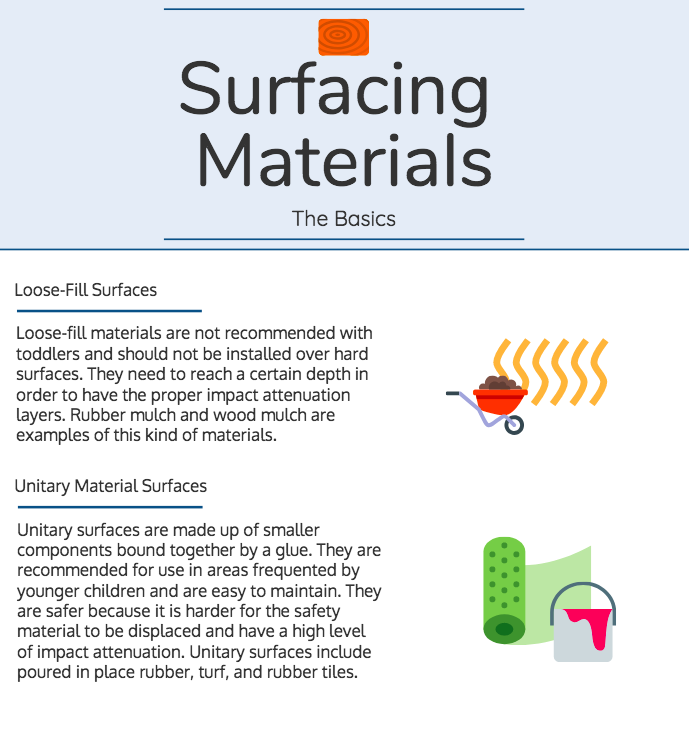Protective Surfacing
There is always a risk of injury on a playground, but the use of proper surfacing materials can prevent them from being more serious and potentially life-threatening. ASTM has developed protective surfacing recommendations based on tests that determine how far a child can fall onto a surface without it being life-threatening.
Some equipment will not need to be surrounded by protective surfacing. Ground-level play elements are exempt from these regulations. This includes sandboxes, playhouses, and ground-level activity walls.
Critical Height
ASTM testing has provided “critical height” ratings for different kinds of surfacing. The critical height is the distance below which life-threatening injuries are not expected to occur in the event of a fall This rating should be provided by manufacturers of ASTM compliant equipment. The fall height from the tallest piece of equipment on your playground needs to be greater than or equal to the critical height rating of your chosen surfacing in order for it to be effective.
Surfacing Material
All playground areas need to incorporate protective surfacing of some kind. Grass and dirt will not be enough to ensure playground safety because it wears easily due to various environmental factors. Concrete, asphalt, and carpeting- unless it has been specifically tested- is also inappropriate for playgrounds as they provide no shock absorption. There are two different categories of surfacing to choose from, and the type of playground, the age of users, and environmental conditions will all determine which of these is the most appropriate option.

Unitary Materials
Unitary materials are usually made up of rubber mats, tiles, or smaller components that are bound together to form a unitary surface. There is a wide range of unitary materials that all have different ASTM ratings from a variety of manufacturers. Some of these materials need to be installed over a hard surface. Darker colored surfacing can pose a risk of burn injuries when they become too hot, so weather and shading need to be taken into consideration when choosing colors. Examples of unitary surfacing are: Poured in place rubber, bonded rubber, rubber tiles, and synthetic turf.
Loose-Fill Surfacing Materials
There are many different kinds of loose-fill surfacing materials, some of which are designed specifically for playground use and are ASTM compliant. These landscaping-type materials can be used and layered to provide the necessary playground protection. They are not recommended for toddlers and should not be installed over hard surfaces. Loose-fill materials also come with certain problems and special considerations; they need to be consistently maintained over time since the materials move around as kids play. Loose-fill materials should initially be installed 25% over the required fill level of the site due to the tendency of the elements to compress over time. To ensure that the material does not drop below the required level the surfacing will require constant maintenance because of this.
Loose-fill materials also need to be used in sites that have good drainage. The presence of too much water will damage and displace the materials. In areas where the ground freezes, this will be especially important to prevent ice, and the fill depth should be larger to account for a harder ground. There might be other ways in which a loose-fill surface does not meet ASTM regulations, and so it is important to consult professional, certified inspectors and installers and to become familiar with ASTM code when using this kind of surfacing.
